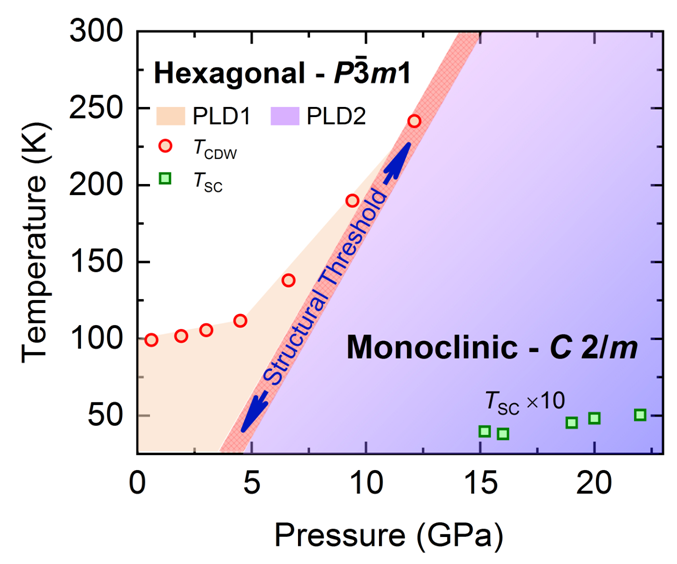Pressure induced novel superstructure-phase in 1T-VSe2 - Drs. Raimundas Sereika and Yang Ding
JANUARY 3, 2020
New work from a team of scientists led by Dr. Yang Ding from HPSTAR discovered a novel superstructure in 1T-type vanadium diselenide (VSe2) that converts sample from two-dimensional to three-dimensional at pressures >16 GPa (room temperature). They revealed that the pressure-induced superstructure is driven by the Fermi-surface nesting and at the same time enhanced by vanadium atoms displacement. The results are published in the Journal of Physical Chemistry Letters.
Superstructure can manufacture versatile new properties of materials by breaking their original geometrical symmetries. It is an important topic in the layered graphene-like two-dimensional transition-metal dichalcogenides (TMDs), but its origin remains unclear.
At low temperature, 1T-VSe2 already has a superlattice incommensurate with the primitive lattice which is distinct from those in the other 1T or 2H TMDs because it extends to the higher temperature when pressure is applied. The team used high-pressure synchrotron x-ray diffraction (XRD) combined with x-ray absorption (XAS) revealing that 1T-VSe2 undergoes two transitions under compression: an isostructural transition at ~7 GPa and a structural one at ~16 GPa.
“The first transition was associated with layer sliding and anisotropic-isotropic-contraction change between lattice parameters”, explained Dr. Raimundas Sereika, the lead author of the work. “In this transition, the weak van der Waals bonds between layers eventually transfers into Heisenberg covalent bonding while the second transition leads to a lower crystal symmetry with a 3*1*1 superlattice”.
“It is unusual that application of high pressure induces a superlattice. In our case even the symmetry is changed.” said Dr. Raimundas Sereika, “Mostly, pressure suppresses such superstructures.”
The x-ray diffraction shows that the superstructure induced by the new phase (highlighted in purple in the image below) is associated with the displacement of vanadium atoms. “From our first-principles calculations we also found that Fermi surface nesting is involved in the superlattice formation”, explained Dr. Yang Ding.
“Our discovery proves that superstructure not only emerges in two-dimensional structures but also paves the way for pressure tuning of three-dimensional structures to manipulate and engineer novel symmetry for disparate real-world applications, such as developing superconductivity”, Dr. Ding added.

Caption: Structural changes in the 1T-VSe2 at different temperatures and pressures.
压力通常会抑制超晶格现象, 北京高压科学研究中心的Raimundas Sereika博士及丁阳研究员带领的研究小组在二维金属型1T-VSe2 中观测到了压力诱导的新型超晶格结构。他们的X射线衍射实验表明1T-VSe2 在高压下会发生两次相变 — 较低压力下的等结构相变以及高压下出现超晶格的结构相变。等结构相变是由层间弱的范德瓦尔斯键转变成了强的共价键而导致。而在更高压力下,钒原子发生错位引起的晶格畸变最终导致了超晶格的出现,同时其由二维转变成为三维结构。他们进一步的第一性原理计算表明超晶格的形成还和费米面的嵌套有关。此发现为研究高压下三维过渡金属硫化物中的超晶格提供了新的思路。该研究发表于《物理化学快报》。
